Equipment for the circumnavigation
On this page is a description of the kit which we took with us at the start of our circumnavigation. Now that the expedition has been completed, we have written a review of our expedition equipment. To find out how we got on with all our various kit and systems please click here to bring up the review.
Most of our kit was self-financed, but we are grateful for some sponsorship from the sources listed on the Sponsors page as well as a number of individual donations from family and friends.
Listed below is all the kit we have taken along with us on the circumnavigation of Britain and Ireland. Where applicable we’ve noted special or useful features and why we have chosen certain items. Please don’t hesitate to get in touch with any queries.
Boat:
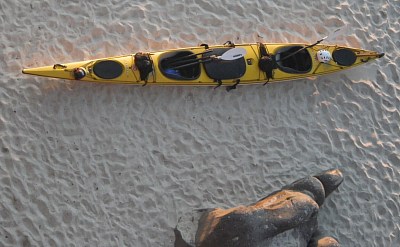 Aerial view of Aleut Sea II |
Aleut Sea II double sea kayak made by Valley - AKA "Persey" for Perseverance! A 22 ft fibreglass double kayak. The middle hatch is a terrific asset as you can place larger drybags straight in without any need to unpack them. The cuboid shape gives very effective & easy storage space. The rudder is essential for this boat due to the length |
We’ve had the Aleut for 6 years now and it’s taken us on some great UK based trips.
- V. Stable in rough conditions -particularly when loaded- and once up to speed, happily cruises at about 5mph. (Andy stripped and re-painted the hull last autumn following one of our longer trips around the SW peninsula, so she’s back to her former glory ready for this trip.)
- Additions: hand pump for Andy in the rear and foot pump for me in the bow – both work effectively, although add a couple of kilos in weight. (No room for foot pump in rear due to rudder system.) Also, deck mounted compasses for each of us. Andy recently fitted a solar panel with a battery mounted under the deck in the large hatch. (See below.)
- The only drawback is the weight of this boat, but we have a trolley for longer portages after landing which has proved invaluable for saving our backs.
Kayak trolley:
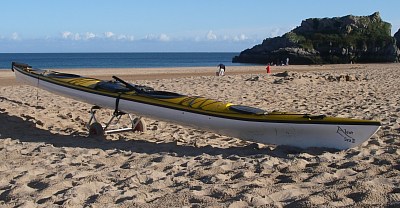 The kayak on the trolley |
This takes up a significant amount of
space in our main hatch but is well worth it. The wheels detach and trolley
folds down relatively flat. At the end of a long paddling day the last thing you
want to have to do is lug the boat several hundred metres to a good camp spot. |
Paddles & Decks & Helmets:
1x Lendal cranked kinetic touring paddles (Jane) and 1 x Lendal Nordkapp paddles (Andy) – both sets split into two halves to allow for storage on the deck, 2 x ‘Epic mid-wing’ split paddles.
The Lendal paddles were bought years ago and we recently bought a kit to make them into splits from Lendal to save the expense of buying 2 new sets of splits each. We’ve been sea kayaking with these blades for years and found them to be fairly light for long paddles and extremely robust.
The Epic mid-wings: These are a lightweight and forgiving wing which is small yet powerful for long distance sea kayaking. They were recommended by a fellow sea paddler. When I borrowed these I knew immediately I wanted a pair and Andy didn’t take much arm twisting once he’d had a go too!
Jane uses a Palm Roanoke touring deck. I find the deck cord really useful for holding waterproof maps on deck. It’s not the most heavy duty deck in the world but easy to get on and off when time is of the essence surf launching/landing and the foot pump gives me extra peace of mind even if it did let anything in – which it hasn’t done so far. Andy now has a Delta deck with shock chord on top to hold the maps down also. Again, it’s not a really high-powered deck, but easy to get on and off quickly and there is the back-up pump system.
Very much bog standard helmets. They spend most of their time clipped to the deck.
Deckbags – We both use non-waterproof ‘bum bags’ bought from a cycling shop some time ago – these have proved plenty big enough for snacks, warm hat/ gloves, safety gear such as mobile phones and light sticks etc. as well as hand lines for fishing. The bags have several compartments and because they sit fairly low on the deck they don’t interfere with paddling. Anything which needs to be kept entirely waterproof is obviously kept in an Aquapac or small Nookie drybag inside the bum bag.
Solar Panel – The most recent addition is a small solar pv panel, the power generated from which will charge various battery powered devices.
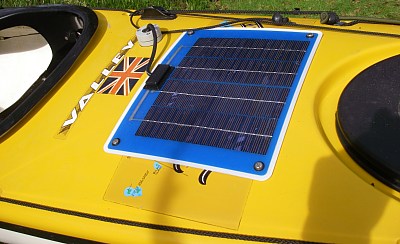 |
Persey's Power Plant - A 5-Watt solar pv panel which we use to charge a 12 V gel battery. We then charge other devices such as phones and vhf radio from the gel battery. |
Clothing:
Jane: I get much colder than Andy does so have decided use a Nookie Assassin drysuit for colder / rougher days and then shortie cag & salopettes combo for milder paddling conditions with the usual thermal base layers.
Andy: Most comfortable in shortie cag or Neo Vest & salopettes but has a heavy duty full dry cag for colder /rougher conditions too.
Footwear:
The ultimate dilemma – bulk & weight of footwear versus dry, warm feet!
At this stage we plan to wear neoprene booties for paddling, wellies for camp and crocs or teva sandals for dry days on shore. ANY OTHER SUGGESTIONS WELCOME!!!
Navigation and Communication:
- 1 VHF Radio.
- 2 Mobile Phones.
- 2 Hand-held GPS Units.
- 1 Spot Satellite GPS Messenger Personal Tracker. A GPS Unit that we can use to transmit our location back to base in Aberystwyth via communication satellite when we are out of range of mobile phone transmitters. It also has an SOS facility for alerting International Search and Rescue, although the advice we have is to not rely on it solely for SOS situations.
Photography:
- 1 deck-mounted GoPro Hero2 wide-angle waterproof video camera.
- 2 Pentax Optio fully waterproof cameras (for carrying in buoyancy aids).
- 1 Sanyo Xacti video camera – for footage on land (?) – If we decide to treat ourselves to it!.
Repair kit:
- Gaffa tape
- Tools: adjustable spanner, Phillips & flathead screwdriver
- Zip oil
- Fibreglass matting, resin, hardener, brush (fibreglass repair kit)
- Sandpaper
- Sewing kit with heavy duty needle & thread
- Spare deck line
- Spare bungy cord
- Knife & scissors
- Tent repair kit
- Thermarest / puncture repair kit
- Bike pump (for trolley wheels)
- Neoprene patches
- Turbo lighter!!!
- Drysuit repair patches / adhesive
Safety & rescue kit:
- Throw line – clipped onto deck of kayak
- First aid kit
- Flares (various – incl. rocket, mini and smoke)
- VHF radio
- Personal Locator Beacon (PLB)
- Mobile phones & chargers
- Light sticks
- GPS Unit
- SPOT Satellite Tracking device
- Head torch each + spare batteries
- Helmets (accessible on deck while paddling)
- Buoyancy aids
- Spare paddles – 1 set each (will be intending to use both sets of paddles regularly)
- Good camp knife
- Maps & Reeds guide for route planning
- Water filter
Long cable lock:
Sometimes we will be forced to land in towns, even cities so a decent lock to lock up the boat to railings gives peace of mind when we have to set up camp away from the boat although it seems extremely unlikely anyone would try to make off with a 22 foot kayak!
She-Wee:
Very useful for long crossings!
Some notes and advice are available here for those interested.
Camping Gear:
- Tarpaulin: 4x4m + 2 telescopic tarp poles. Our Robens Tarp was on our wedding list and we take it on every trip – and it’s still going strong! It’s a brilliant extension to our tiny tent. If it’s raining heavily you can place it over the entrance to the tent to avoid getting wet every time you exit and it gives you that bit of extra space for your camp. (No good in high winds though.) The tarp poles double up well for a washing line too.
- Tent: We use a small 2-man Macpac Minaret. We’re on our second minaret as we liked the first one so much and simply wore it out. (Good for spares now!) Loads of useful pockets inside. Low profile. Dark green, so inconspicuous and therefore perfect for wild camping. Lightweight and can be erected in literally 4 minutes.
- Therm-a-rests - ¾ length to save on weight and space, sheet over both.
- Single down duvet - much more sociable and it feels more like bed! The down obviously must not get wet so reliable drybag to store it in required.
- 1 pillow case each - stuffed with dry clothes for pillow padding
Food:
We have tried lots of different types of food and various methods to store it. Last year during our two-week exped around the Southwest everything which could leak, DID leak! The main food bag become quite disgusting and it was difficult to find things if setting up in the dark. Also, because the kayak is so big we’ve tended to take too much food in the past, weighing and slowing us down.
SO ………. OUR NEW (and hopefully improved) SYSTEM WILL BE AS FOLLOWS :-
A large plastic box with clip-lid containing mostly other labelled clip-lid containers and bottles for basics, such as salt, sugar, milk powder, porridge oats, squeezy maple syrup and local runny honey (for porridge!), herbs, butter, oil and a large tub full of home-made dehydrated food, including spag bol & chilli. In theory, all food will fit into ‘THE BOX’ which will limit us to a sensible amount of food.
Outside of the box will be a small BDH style tub full of rice and another full of GORP (Good Old Raisins and Peanuts …. And anything else we feel like e.g. other dried fruit, smarties etc.)
In the deck bags we have all the snack food for a couple of days – choc bars, a small tub of GORP (replenished as needed from the BDH), fishing lines – we love fishing from the kayak and often catch something to cook up. This is why we have rice rather than pasta. Also, rice seems to be better use of space.
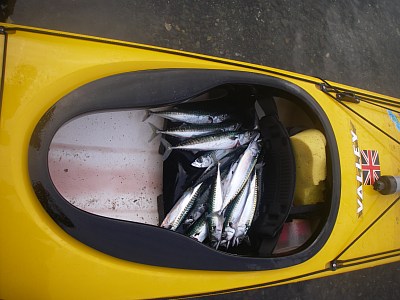 |
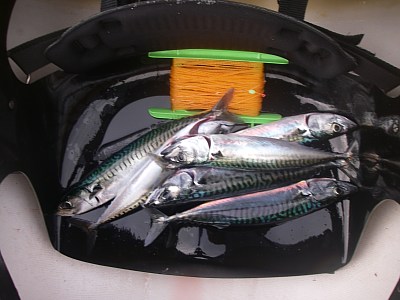 |
| Mackerel caught from the kayak using a simple handline on the Isle of Skye | |
Water:
A supply of fresh water tends to be one of the big challenges of longer sea kayaking trips. We need about 4lt available for drinking during the day and nearly the same again for cooking, hot drinks in camp etc. We’ve got a couple of 2lt MSR carry bags and a 4lt Ortlieb bag with tap. Then, we’ve got camel back bladders and spares which can be filled and often stored behind our seats. (We’ve also got a water filter pump or rely on boiling up stream water if happy it’s clean.) Rain water collects nicely off the tarp too if you pop a trangia pan beneath a weighted run-off corner!
Cooking:
We have a Storm Kettle for most of our hot water needs, which burns twigs and saves our gas. We also take a trangia with gas attachment. (Looking into getting the new Biolite Stove – but they are not yet available in the UK.)
Update: We’ve decided against the Bio-lite stove due to its cost and our dislike of the noisy fan. We will stick with the Storm kettle which we know and love, despite its bulk. We’ve purchased a pan stand which sits neatly in the top so we can boil water and cook a separate pan of food all at once!
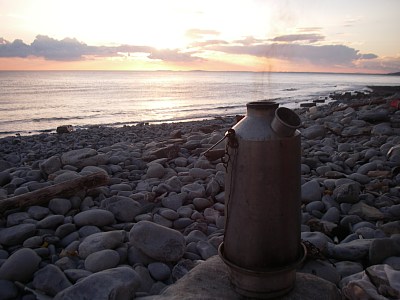 |
Storm Kettle - We use our storm kettle virtually every day when on exped. It is fuelled by twigs and will boil 1.2lt water in about 5 minutes. One of our favourite pieces of kit! |
On this page is a description of the kit which we took with us at the start of our circumnavigation. Now that the expedition has been completed, we have written a review of our expedition equipment. To find out how we got on with all our various kit and systems please click here to bring up the review.